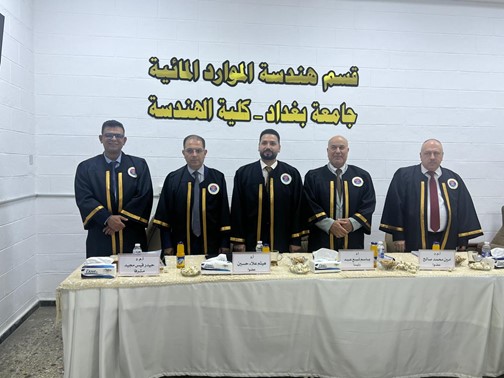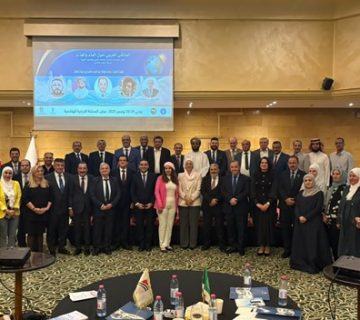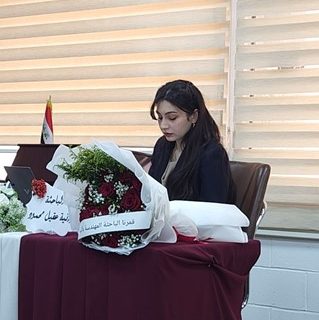The College of Engineering at the University of Baghdad hosted the public viva of Master’s student Hadi Amir Abbas from the Department of Water Resources Engineering for his thesis entitled:
“Effect of Regulator Gate Operation on Scour Depth at Al-Kahlaa and Qal’at Saleh Regulators in Maysan Governorate, Iraq”
This took place on Wednesday, 14/5/2025, in Dijla Hall at the Department of Water Resources Engineering. The examination committee consisted of Prof. Dr. Basim Shaba Abed as Chair, with members Prof. Dr. Haitham Alaa Al-Shami and Asst. Prof. Dr. Ameen Mohammed Saleh, and was supervised by Asst. Prof. Dr. Hayder Qais Majeed.
The main objective of this research was to study the effect of gate operation on local scour downstream of Al-Kahlaa and Qal’at Saleh regulators in Maysan Governorate, which were selected as case studies. The aim was also to determine the optimal operational conditions for these structures. The Flow-3D software was used specifically the RNG turbulence model to simulate water flow. The sediment scour theory was also adopted to model sediment movement under different flow conditions and gate-opening scenarios.
The researcher arrived at several conclusions:
To verify the cross-section and flow characteristics of the regulators, field measurements were carried out using the “River Surveyor” device. The average velocity calculated using the numerical model was compared with that obtained from field data. Results from Flow-3D showed high agreement with field measurements, with R² values of 0.967 and 0.94, and Nash–Sutcliffe efficiency (NSE) values of 0.98 and 0.94 for Qal’at Saleh and Al-Kahlaa models respectively. Maximum relative differences were 7.9% and 5.88%.
The study’s methodology showed that the number of open gates and their operational pattern significantly influence the scour development downstream of the regulator. The maximum scour depth was observed when a single gate was opened on one side under steady flow, which resulted in scour depths 1153% greater than when all gates were opened in the Al-Kahlaa model, and 570% greater in the Qal’at Saleh model. Therefore, the optimal operational scenario is to open all gates, while the worst scenario is opening only one gate on one side.
Moreover, there is a direct relationship between flow rate and scour depth. As flow rate increased (ranging from 50–200 m³/s for Al-Kahlaa and 75–150 m³/s for Qal’at Saleh), the depth and extent of scour also increased, indicating the strong impact of flow rate on erosion severity. Generally, scour is significant when only one gate is opened but gradually reduces as more gates are opened.
Recommendations and suggestions for future studies:
- The thesis recommends avoiding asymmetric gate openings, as such scenarios increase erosion.
- Avoid sequential gate operations when not all gates are open; instead, follow a non-sequential gate operation scenario. Non-sequential operation was shown to produce a more favourable velocity distribution.
- Future studies should consider a variety of sediment sizes, investigate partially opened gate scenarios, and study the effect of gate operation on sediment accumulation upstream of the regulators.
- Investigate scour downstream of regulators during flood conditions.
The viva was attended by Prof. Dr. Faleh Hassan Mohammed, Assistant Dean for Administrative Affairs at the College of Engineering, along with several faculty members from the Department of Water Resources Engineering and postgraduate students.








